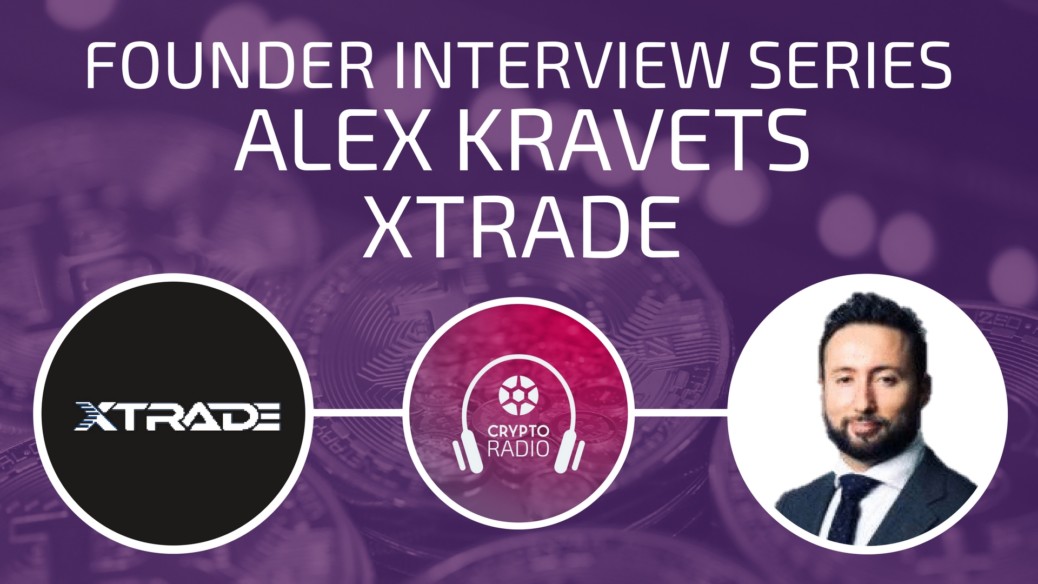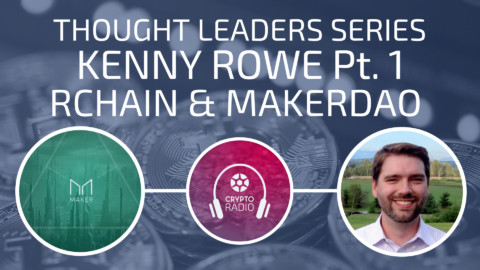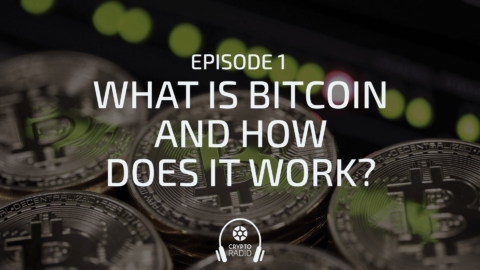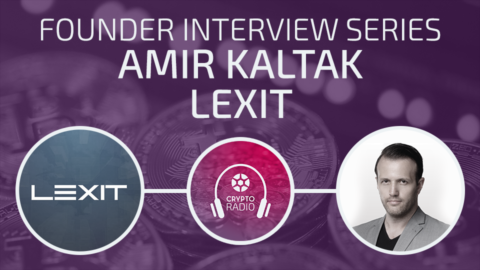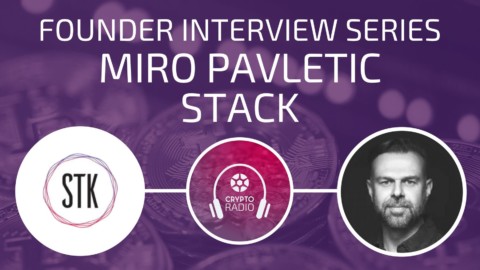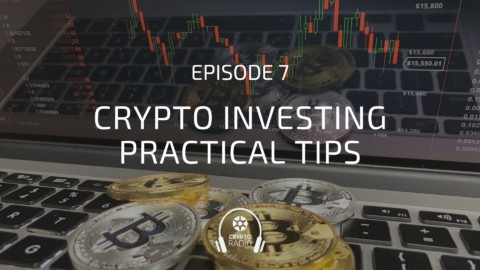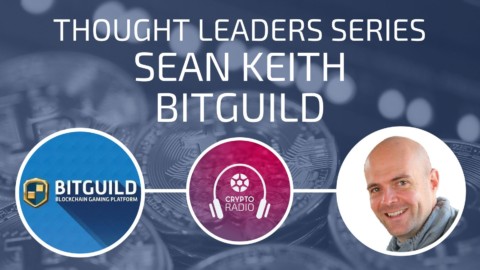Podcast: Play in new window | Download
Euvie: [00:00:30] Welcome to Crypto Radio, I’m your host Euvie Ivanova. In this next instalment of the founder interview series, our guest is Alex Kravets, the founder and CEO of XTRADE. XTRADE is a new cryptocurrency platform that helps solve the common problems in the fragmented crypto market, for example, the difficult navigation through multiple accounts on crypto exchanges or waiting too long for your orders to be executed.
These guys are creating [00:01:00] four products based on blockchain that could bring crypto trading to the standard of Wall Street technologies. They’re raising 45 million to build the platform and make all of this happen and the public token sale on February 10th , 2018. Today, Alex walks us through the idea beyond XTRADE, the products, the road map, the team, and all the other things you need to know. For all the show notes go to cryptoradio.io/ XTRADE. So, why don’t we start with your elevator pitch?
Alex: [00:01:30] Sure. So, my name Alex Kravets, I’m the co-founder and the CEO of XTRADE.io and what we’re doing is we’re fixing some of the problems in the cryptocurrency space such as fragmented markets, varying APIs, and difficult order entry systems by creating products from the Wall Street space that we’re all from. So, it’s essentially one API to access all markets, one trading platform to be able to place orders normally across multiple markets without having to use multiple webpages.
A program where you can actually trade across [00:02:00] multiple markets by using our liquidity. So, you just open one account with one exchange and trade at every other exchange. And a dark pool to allow large institutional order executes quickly and without moving the actual trading markets, sort of a safe place to transact in large blocks. We’ve already built the first products and we’re running a token sale Q1 of 2018 in the next few weeks to raise our funds. We’re doing 45 million on a hard cap [00:02:30] and that is basically mostly to do the liquidity aggregation portion of our product. So, we’re excited to bring the product to the space. We think it’s really neat and we’ve got a lot of great feedback, a lot of awesome supporters. That’s kind of where we’re at with it.
Euvie: Cool. So, why did you start this project?
Alex: Well, we started trading crypto. I have 12 years as a trader, running a brokerage from the operational standpoint and marking data execution goal location high frequency trading, and so I know how things should be working. And I saw the opportunities in the crypto markets that trade and make money, [00:03:00] because the arbitrage opportunities between markets are so great. In the equity space, things settle in once place. In crypto, they settle in each individual market, so there’s a lot of arbitrage. But the problem is the interfaces really suck.
Basically, everything’s a webpage and even if you try to write an algorithm to trade you have to write to each individual exchange’s API. So, if you have five exchanges you have to write the five IPAs. 10, 10 APIs. It’s a huge pain. I saw the opportunity to create a product that would fix a lot of these problems, simply by leveraging what’s already out there in the financial space and bridging the gap between Wall Street and crypto. So, that’s exactly what we’re doing.
Euvie: [00:03:30] Do you have any competitors in the space?
Alex: We have some competitors, but mostly they’re doing different things. One is Coinigy, which does web-based platform that trade across multiple markets but they’re slow and they’re using not industrial grade APIs. It’s more like for the retail investor, like a Quantopian product. The second company’s Omega One, and what they’re doing is they’re taking large orders and working them across multiple markets for you, but the problem there is that the orders are actually visible on their chain and they do all the execution. [00:04:00] With us, we’re more about providing direct market access to active traders and funds that actually know how to trade.
Another one is Coin, out of Japan. So, they’re doing a pretty good job dealing liquidity aggregation and their coin actually acts as a fungible mechanism between other coins. But for us, again, we’re more of a direct market access product that’s allowing people to trade directly with the market without going through a different coin, a different layer. We’re simply facilitating multi-market execution at a very direct and efficient manner, and acting as the bag of own for a lot of these transactions and also [00:04:30] for a lot of different systems that do other multi- [inaudible [0:04:32] executions.
We’re not just a platform for the fund and user, we’re also a white label platform that you can take and actually put into the back end of your system to trade crypto. So, we’re that industrial institutional product that’s not really there yet. So, there’s really no competitor as far as what we’re doing and we’re excited to be the first ones to bring this kind of solution to the market.
Euvie: And how far along are you guys with the project right now?
Alex: Pretty far. So, we’ve built the first product. We’re actually like an ICO that has a product, which Is rare in this space. So, the product is the fixed API. In the financial space [00:05:00] every order entry system and market data system is written in different languages and obviously has different parameters, but they all communicate with one language called FIX, which stands for financial information exchange. It’s been around for 25 years. So, most institutions and traders actually know how to write to that API to trade everywhere else, they’ve been doing it for a very long time.
So, we’re writing a system in that language so that you can actually write just to our fixed API and then trade multiple markets at the same time. That’s already built, we just have to add more markets to it. That’s going to be released into production [00:05:30] at the end of Q1 of this year, of 2018, and then subsequent to that we simply add our trading software layer on top of that which we already have in place.
We just have to put it into production in the next few months and then with the liquidity aggregation we open multiple accounts and employ our trading algos to execute across multiple markets from just one account at a partner exchange. Which, we already have a partner with CEX.io. That’s really it, we’re pretty confident we’ll be able to deliver because this is off the shelf stuff for us. We’ve already built this. My partner’s build these systems for many years, so there’s really [00:06:00] no challenges here beyond implementation, which we’re fairly comfortable with.
The last product, which is the dark pool, we have a matching engine that we can use and essentially a Fiat partner that can take Fiat deposits. So, somebody can wire 10 million dollars into a bank account, go through KYCML who can facilitate the crypto side of the transaction and the bank can facilitate the Fiat side. And that’s also very simple, especially because liquidity’s not displayed. That’s something that we can implement fairly quickly, as well. So, we’ve basically built our first product and we have the other ones that are going to come up [00:06:30] fairly quick based on our road map. We’re pretty excited about it.
Euvie: Cool. Yeah, you’ve mentioned a few things that you guys have on your road map. What else do you have planned for the next 6 to 12 months.
Alex: Well, I think the four products, there’s enough. We’re going to focus on building the four things that we think are very important as the primary drivers for liquidity in the space. And from there, obviously just client acquisition. We’ve had a lot in interest from institutions, from traders, from a lot of my previous clients in the brokerage space who ran large groups of traders in China [00:07:00] and other countries that are very interested in trading crypto in a massive scale.
They just really don’t have a platform to do it and so it’s simply a matter of connecting the dots that we already have to create relationships to leverage our existing relationships and technologies to bring the technology that we’re used to to the crypto space, to make it a little more modern, a little more efficient, and a little less prone to volatility, and bring a little more liquidity to the markets.
We think that’s very important for crypto [00:07:30] right now, because it moves very quickly and it’s very fragmented and it has to be a little more centralized as far as being able to access multiple markets without having to open 100 accounts or having to write 200 different programs or to open 9 webpages. So, we’re solving that very, very basic problem and we think it’s going to be really, really great for the trading space in the crypto environment right now.
Euvie: Yeah, it sounds like you guys are positioned really well with that, it’s solving some real problems.
Alex: Yeah, yeah. Now, it’s very visceral. [00:08:00] Anybody who trades crypto knows about it. You have to open an account, then you have to wait for it to get approved, then you have to send money and then sometimes you don’t get your money back. Sometimes you click on the order, it doesn’t go through, and you can only do a limit of market orders and your stop orders don’t work. It’s just kind of a nightmare, right? And if you have multiple accounts it’s just that times 20, that times 30, whatever it is. It’s not twice as hard if you have two accounts, it’s four times as hard to do it at the same time.
We’re basically just solving that very simple problem by creating an interface that’s going to allow you to trade [00:08:30] quickly and easily across all your accounts without having to deal with a lot of these issues that the exchanges are currently experiencing. Yeah, it’s fairly basic but fairly useful. It’s an infrastructure project, it’s not a [inaudible [0:08:42], it’s not a tokenization of your [inaudible [0:08:45], it’s not something ethereal, if you will.
It’s really something very direct, very basic. It’s a very simple solution, well, complex, but for us, simple solution to a very basic problem that’s experienced by pretty much everybody in the space and where the infrastructure play to facilitate that movement [00:09:00] to make the markets better, as far as trading is concerned.
Euvie: What are some of the milestones and challenges that will determine your success in this?
Alex: I guess the milestone initially is going to be complete our token sale, which looks pretty good at this point. We have quite a substantial amount committed, more than we actually need in our pre-sale, in our pre-sale whitelist indications. We’ve done pretty well with raiding funds privately, as well, so we feel very strongly that we’ll hit our target [00:09:30] or we’ll have enough actually execute on our vision. From there, it’s just a matter of coding to create the projects that we need, to hire the right people to propagate the product. And, again, we have plenty of people there.
So, I think really the challenge is simply execution, bringing the technology that we have into the space that needs it. As far as working with exchanges we can simply write to the exchanges API, we don’t really need to have any sort of specific relationship, so that’s really good. As far as liquidity aggregation, again, [00:10:00] we have our partner exchange already. We can, I think fairly quickly, add a few more that we need. But we can really work with the one that we have. So, it’s really just implementation and carrying out our vision, just by execution of the projects.
Euvie: Can you tell us about your team? Let’s start with your core team?
Alex: Sure, so it’s myself. I started as a proprietary trader trading equities in the year 2001. I basically was sat in front of the computer and tell it to make money or else. I guess it was or else, and from there [00:10:30] we basically built a brokerage from around our trading platform, which was a clearing [inaudible [0:10:33] broker dealer. We catered pretty much to every facet in the market for high frequency traders to the simple investor whose dollar quest average is $100 every quarter.
So, I’m very familiar with the full vertical of market data execution, trading software, settlement, clearing, support, risk managements, [inaudible [0:10:51], trade reporting, pretty much everything that’s in that space I know because I literally had to do it as we grew. My partner, [00:11:00] Sergey [inaudible [0:11:01], acts on software. He’s built, modified, added to, removed from, and created systems in the space, from market data, from execution, from location, from high frequency trading, for retail platforms. Even like gambling platforms and FX platforms, equities, derivatives. So, he’s literally built this stuff from the ground up over and over again.
He’s very knowledgeable, so we’re taking a lot of the stuff that he’s built of the shelf literally and then plugging it in to what we need to build. Our other co-partner, John [inaudible [0:11:29] is worked [00:11:30] [inaudible [0:11:30]. JP Morgan has a great set of relationships and institutional space, was instrumental in getting out initial indications of interest from clients and investors. And is very well connected and is able to facilitate those relationships. So, that’s going to be a very strong point in the [inaudible [0:11:44] acquisition side and also the operational side. He is very qualified as an operation and action in the entrepreneurial space, as well.
It’s a really good fit for us. From there, we have multiple developers that work under Sergey, I think six or seven guys at this point. We have a great [00:12:00] growth team, a marketing team, a PR team. We have really great advisors ranging from the CEO of Divisa Capital, Mushegh Tovmasyan, who’s just joined us that’s a large effects broker out of the UK. They just raised 100 million last year. They have four different operations that they run in the FX space. We have people that anchor CNBC, we have guys who created products in the space like the [inaudible [0:12:23]. Pioneers like Steven Wasserman, Lex [inaudible [0:12:26] who’s one of the best newsletter publishers in the space [00:12:30] who basically writes the book on hedge funds and crypto funds, and is able to make a lot of connections for us, as well.
So, very well-rounded scene, very active in the space, both from the crypto side, from the financial side. We’ve been very lucky to have these individuals work with us and we feel that there’s a lot of complementary synergies there that will help us execute our vision now and in the years to come from these individuals.
Euvie: Alright, so let’s talk about your tech. Can you explain the utility value of your token?
Alex: [00:13:00] Absolutely. So, the token is a pure utility token meant to be used to pay for services on our network. So, all of our fees, like execution fees, market data fees. Because we’re actually going to aggregate all the market data from multiple exchanges and create a normalized feed which is very useful to anybody who trades or creates data products, creates data references products like daily crosses and things like that, like the CMA and other guys.
So, another product that we have is co-location, so you can actually write your API and put it in our data centre environment. [00:13:30] We have co-locations in Chicago and New Jersey, DC3 and MY4. So, your latency is like 1.5 milliseconds to the exchange versus 200 milliseconds over the internet. So, those charges will be denominated in tokens. So, every charge that we have will be denominated in tokens and if you hold a certain amount of tokens you’ll have a 40 percent off on all the charges. Essentially, the token is used as a utility token to pay for services, it’s in the RC20 token. So, that’s’ our use case for the token, payment of services utility. Very simple.
And technology behind what we’re doing is superior financial technology, [00:14:00] it’s been around for a very long time that we know exactly how to implement. So, it’s a universal API based on the sixth protocol for market data and for execution. So, we’re able to write to one set of specs and be able to trade everywhere with multiple exchanges. Downloadable platforms that we’ve built and facilitated and created obviously also. So, stand alone applications that have N2N encryption that are not webpages, not subject to man in the middle [inaudible [0:14:24] to go over private internet, over whitelisted IPs, matching engine technology, [00:14:30] market data technology, low latency, high frequency execution, infrastructure, hardware. Basically, very advanced financial technology and hardware and software applications that we’re leveraging, coming from equity trading and the FX trading space into the crypto currency space.
Euvie: And can you tell us about your marketing plans for, let’s say, the next 6 to 12 months?
Alex: Sure, so right now we’re focused primarily on running the ICO. As far as marketing for the product [00:15:00] itself, we have a long waitlist of people who are waiting to use the product. Basically, everyone we’ve ever talked to wants to trade using our product and thinking that’s from personal experience some of the people that we’ve talked to. Essentially, we don’t see any issues getting our first reference clients in. From there, it’s just a matter of attending trade shows, going to the right events, network with the people that we already know, offering solutions to the people that really, really, really need them.
We’re selling water to very thirsty people here, honestly, [00:15:30] who want into the space but don’t really have a way to do so that’s mitigated in a way that’s normalized for them. Obviously, getting out there as far as doing the actual digital marketing and older elements [inaudible [0:15:42], but essentially, it’s just relationships. It’s people that we know in the space, people we’ve built systems for, people that we can partner with who can offer their product on top of their existing suite of services which is very attracted to them and to us and to their clients. So, just creating those win, win, win situations across the entire line of our delivery system for our products, [00:16:00] which we know how to do we’ve done this in the past. And we’re going to be doing this in the future, as well.
Euvie: Are you targeting people globally?
Alex: Initially, we’re targeting institutional and high frequency traders. People who have order entry systems, that’s the fixed API, and that’s primarily focused in the US initially, because that’s our core market. But obviously, as soon as we launch our more of a worldwide [inaudible [0:16:20] trading product we’ll be targeting worldwide they’d basically trade. Any one who goes active with trade can use this product. So, that’s [00:16:30] an easy thing to propagate around the space. Liquidity aggregation, obviously, is very attracted, so anybody who can open an account at one of our partner exchanges will be able to trade everywhere else, so that’s quite useful.
So, we think it’s really a worldwide population that’s our target down the next few quarters, and the products that we’re building are very complementary to that mission. So, initially it’s going to be the high frequency guides and institutions from there more towards that middle market of active traders.
Euvie: Alright, so let’s talk about your token sale. How much money are you raiding [00:17:00] and what’s your hard cap?
Alex: So, we’re raising 45 million dollars. 70 percent of that money is going to be used for our liquidity aggregation product because we actually need to put accounts on multiple exchanges, do trades and move the positions around back and forth to settlement continuously between multiple exchanges. And so, based on the current trading volumes of, let’s say, 10 to 20 billion, let’s say, a one percent market share. We’re probably getting about 200 million, based on exchange margins it’s 3 to 4 to 1 to do that and then obviously we can leverage inter-exchange [00:17:30] margin that already exists, credit lines from other places that we’re fairly familiar with.
So, that’s kind of what our target is and we’re pretty successful as far as having raised a substantial amount of that at this point and we have a very good set of indications on our pre-sale whitelist which is still just starting to fill up. I think we have about 2,500 people on there so far, which is pretty good. So, that’s what we’re doing as far as the raise is concerned. Right now, we’re just about to launch a public pre-sale on [00:18:00] February 20th, which will announce terms to those people who whitelist. If you go to XTRADE.io/whitelist you’ll be able to register for the whitelist.
It’s for US accredited investors and investors outside the US that would like to participate. If you’d like more information, just go to XTRADE.io. You can join our telegram chat, I think we just crossed the 3,000 mark as far as membership there, and you can ask questions. We have a chat bar that’s happy to answer as well as us. And we’re all over our [00:18:30] social media, you can check there, as well. But primarily, if you register for the whitelist you’ll be able to get more information about that.
Euvie: I wanted to ask about the founder’s tokens. Is there a vesting period?
Alex: Yeah, so we are locked up for six months on the founder and the team tokens.
Euvie: And what is the date of the crowd sale?
Alex: We don’t really know if we’ll do a crowd sale yet, because based on what we’re seeing on our side we probably won’t get there. But if we do, it’ll be towards March, very likely, and that’s when we’re actually going to generate all the tokens [00:19:00] to distribute to everybody that participated in the sale before that. So, the next major step for us is going to be the public pre-sale, which we’re focusing on in the next week and a half or so. That’s going to be on the 20th.
Euvie: Okay. What’s the estimated date that the tokens will be distributed?
Alex: Again, it’s going to be at the token generation event, which is equal to the public crowd sale, but that might not be necessary. So, we’re going to determine that date very soon following the public pre-sale. It’s going to be very likely in March, and we’ll announce that [00:19:30] as soon as we possibly can.
Euvie: Alright, great. So, let’s finish with a quick pitch. Why should people get involved in your project?
Alex: We’re different than a lot of other ICOs, in the sense that we’re not creating very lofty goals and creating a product that we’re going to deliver in a year, six months, that may or may not work, that may or may not have users. We’re not trying to solve a problem that doesn’t exist. We are looking at very simple problems in the trading space that everybody’s familiar with. We have very, very effective solutions that have been around for 25, 30 [00:20:00] years that we know how to build, that we know how to implement, that we have the experience doing.
So, our project will be successful simply because we’re addressing a real problem with a real solution, and we’re really the first ones to do it. So, it’s very much a picks and shovels type of play. An infrastructure project, a real project. A project that brings real technology to a real problem, and creates real solutions for real users which is most of the cryptocurrency trading community. Because everybody that invests pretty much trades, and everybody has those same pain points which we’re hoping [00:20:30] to solve.
So, I really think it’s going to be something that’s very, very beneficial to the space in terms of trading interfaces, in terms of adding liquidity from institutions. And I think using the token is going to be obviously an important thing to trade on our platform. So, for that reason, I’m very excited about the project and I think if you take a look at what we’re doing, if you go to our website XTRADE.io and read our white paper, you will see that our mission is very direct, very straightforward and very, very much executable. So, that is the primary driver [00:21:00] for what we’re doing is to deliver that value using the systems that we already know and making a space a better place for everybody.
Euvie: Great. Thanks so much for joining us today Alex.
Alex: Thanks, Euvie, I appreciate it. A pleasure to speak to you. Fantastic interview, thanks.
Our guest in this installment of the Founder Interview Series is Alex Kravets, founder and CEO of XTRADE.io.
XTRADE is a new cryptocurrency trading platform that helps solve common problems in the fragmented crypto market. For example, the difficulty of navigating through multiple accounts on crypto exchanges, or waiting too long for your orders to be executed. These guys are creating four products using blockchain technology that will bring crypto trading up to the standard of Wall Street. They are raising $45m to build the platform, and in this interview Alex Kravets walks us through the idea behind XTRADE, the products and their roadmap.
Why four products?
As Alex explains, XTRADE approaches the problem of the fragmented market in a systematic way. The team behind this project includes two more founders, Sergii Gulko and Jon Giacobbe, and a number of advisors and developers with a trading, tech and entrepreneurial background. They are building a unified platform that will address four different aspects of crypto trading:
- FIX API (Application Programming Interface) will enable traders to connect to all major crypto exchanges using one simple interface. This will improve the current situation where each exchange has their proprietary API, which is difficult to maintain.
- XTRADE Pro will be a trading platform that aggregates prices from all exchanges in real time and speeds up the execution of orders.
- XTRADE SPA stands for the Single Point of Access. It means that traders won’t need multiple exchange accounts anymore. Instead, they will be able to access all crypto markets from one single account.
- XTRD tokens are used to pay for services on the XTRADE platform and they will be cycled back into the community. The public token presale began on February 10th, 2018.
Resources
- XTRADE Whitelist
- XTRADE White Paper
- Crypto Radio Episode 07: Crypto Investing Practical Tips
- Crypto Radio Episode 06: Beginner’s Guide To Crypto Investing

